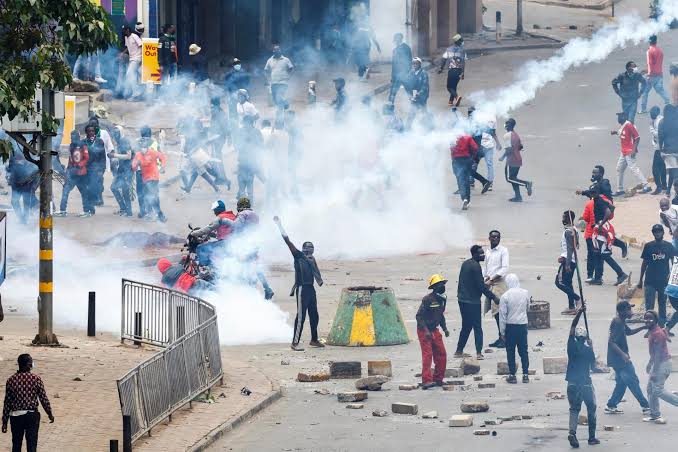
NAIROBI.
At least nine people were killed, about 400 injured, and 61 arrested in various police stations on a Black Wednesday, as at least 27 counties witnessed protests marking the first anniversary of the June 25, 2024, demonstrations that saw youth protesters—mainly from the Gen Z generation—storm Parliament.
According to the state-funded Kenya National Commission on Human Rights, eight deaths were registered in six counties—all from gunshot wounds –with two in Machakos, two in Makueni, and one each in Kiambu, Nakuru, and Nyandarua.
“Over 400 casualties have been reported including demonstrators, police officers and journalists. Most of them were treated and discharged, 83 of them were referred for specialised treatment, eight with gunshot wounds,” said Dr Raymond Nyeris, the commission’s vice chairperson, who also reported “excessive use of force, including the use of rubber bullets, live ammunition and water cannons”.
Wednesday evening, Kenya Power confirmed another death, after a security guard was fatally shot outside Stima Plaza in Nairobi. “We are deeply saddened to report that Mr Fred Wamale Wanyonyi, a security guard stationed at our Stima Plaza headquarters, was fatally shot at the entrance of the building at 4:30pm Wednesday evening during the ongoing protests,” Kenya Power said.
“Mr Wamale, an employee of Hatari Security, was on duty at the Kolobot Road entrance when the incident occurred. He was rushed to Mama Lucy Kibaki Hospital, where he was pronounced dead on arrival.” The figure promises to soar, with the Law Society of Kenya, Police Reforms Working Group and the Kenya Medical Association in a joint statement said: “eight protesters who were killed” during the Wednesday protests. “At least 400 others were treated, with 83 of them referred to specialised treatment for serious injuries. At least 8 protesters have been treated for gunshot wounds. Three of the injured include police officers,” the CSOs jointly said.
The pain, the loss of life, and the grief gripped the country once more as Kenyans took to the streets to commemorate the 60 lives lost a year ago. Their memory cast a long shadow over a nation still searching for justice, and now the additional losses stoking the flames of grief, anger, and renewed calls for accountability. While these figures are confirmed by medics and human rights defenders, “sadly, the exact figures may only be known in the course of time,” explained the group in the joint statement.
By Wednesday evening, the Kenyatta National Hospital had admitted 90 people nursing injuries from the protests, including from gunshot wounds. “We have received 90 casualties, and I know the number will go up. Our teams are working hard to stabilise all the patients and take count of the injuries. No final breakdown yet,” a medic aware of the situation but barred from speaking to the media said. It was a day of running battles as police were deployed heavily on the streets of the different towns, with the action mostly in Nairobi.
The protests also rocked Mombasa, Nakuru, Kisumu, Uasin Gishu, Kajiado, Makueni, Machakos, Nyeri, Embu, Nyandarua, Murang’a, Laikipia, Meru, Tharaka Nithi, Kiambu, and Kirinyaga. Others were Taita Taveta, Kilifi, Lamu, Narok, Busia, Kisii, Homa Bay, Kakamega, Bungoma, and Kericho.
The protests movement, amplified through social media platforms like X and TikTok, saw hashtags #SiriNiNumbers and #OccupyStatehouse2025 dominate online conversations, with #SiriNiNumbers ranking fourth among globally trending hashtags as at 8pm Tuesday , according to trends24, a website that tracks and displays trending topics on Twitter, both globally and within specific countries or cities. In all, the site said the hashtag was featured in 7.7 million tweets over a six-hour period.
Two people succumbed to gunshot wounds after police opened fire on protesters at Emali Township in Makueni County Wednesday, the head of Kilome Nursing Home Stan Mulei confirmed.
The two men who “had sustained gunshot wounds on their chests,”Dr Mulei said, were pronounced dead on arrival at the facility. The two were part of youthful protesters who engaged the police in running battles throughout the day. They had barricaded the busy Mombasa-Nairobi highway using rocks and bonfires, paralysing transport services.
Two other people, separately succumbed to gunshot wounds at the Matuu Sub-county Hospital and Matuu Mission Hospital in Machakos County when police opened fire on protesters. Matuu Sub-county Hospital administrator Julius Makau and the head of Matuu Mission Hospital Sister Felistus Kasyoka confirmed the deaths.